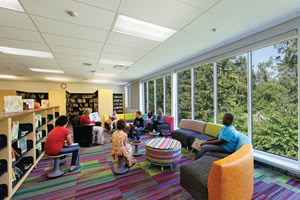Think Differently

PHOTO COURTESY OF FANNING HOWEY
Making the most of existing resources
is a central tenet of sustainability. For school facility
managers across the country, stretching resources to their
limit is also an absolute necessity. According to a 2016 study by The
21st Century School Fund, our nation’s public schools face an $8-billion
funding shortfall for annual operations and maintenance. In this environment,
how do you position your buildings and staff for long-term
success? The answer starts with making smart decisions during capital
improvement projects.
Think Differently
In many states, capital improvement projects have a different funding
source than maintenance and operating budgets. So it is important to
leverage capital project funds to reduce operating expenses down the
road. This starts by taking a holistic approach to evaluating return on
investment.
For example, replacing fluorescent lights with LED lights yields a poor
payback when looking at simple energy costs. But once you add in the
savings from reduced maintenance activities, including lift rental or contractor
costs, the investment becomes more appealing. Now look at the
efficiencies gained by avoiding the long lead times for fluorescent bulbs
(now up to six months), and you begin to uncover a
compelling case for LEDs.
To think differently, you must take a collaborative
approach to planning and design. Make sure to
involve maintenance and operations staff in design
conversations during capital improvement projects.
Discuss current maintenance activities and identify
activities you would like to reduce or eliminate in the
future. These conversations often lead to a focus on
the upkeep of flooring systems. Carpet tile is especially
popular right now because it is virtually maintenance free, except
for regular vacuuming.
Expanding the number of stakeholders leads to many creative solutions.
At one new middle school, the client requested a large format
(24 inches x 48 inches) porcelain tile to reduce the time and expense of
regrouting in future years. Many districts are moving to epoxy paint
in all spaces. The durable paint allows staff to simply wipe down wall
surfaces. The time spent repainting is eliminated, and the result is
lower operating costs without a sacrifice in environmental quality.
Look Ahead
When designing for long-term value, don’t just look at the project in
front of you. Talk about how your operations and maintenance staff will
be evolving. Also discuss your district’s vision for education. Then target
your capital project investments where they will make the biggest impact
in the future.
For example, many schools do not think about the additional maintenance
costs associated with 21st-century learning environments. Mobile
furniture costs more over the long term. Casters on desks, tables and
chairs are the first things to break down, and must be fixed or replaced.
The same goes for cylinders on adjustable-height furniture. To reduce
long-term costs, many schools are careful about
where they invest in mobility. Which items need
to be instantly reconfigurable? Which can be more
fixed, thereby reducing future maintenance expenses?
The answers to these questions should play
a role in guiding your capital project decisions.
Because capital projects are the primary
driver of building improvements, make sure to be
opportunistic when funds are available. A singleclassroom
LED retrofit costs between $5,000 and
$6,000. This is well beyond the capacity of most maintenance and operations
budgets. So when you have the opportunity, pull the trigger on lighting
upgrades. Energy code changes are quickly making all fluorescent
lights obsolete. If capital project funds provide the opportunity, make the
leap to LEDs and eliminate the cost of multiple lighting system retrofits.
Identify Opportunities
Opportunity cost is an often-overlooked aspect of design. Imagine for
a moment that you make the decision to move from fluorescent lights to
LEDs. You not only reduce energy and maintenance expenses, you also
eliminate the need to store a multitude of lamps and ballasts. What could
you do with this extra space? What could it become, and what is the value
of that opportunity?
The analysis of opportunity costs is just one aspect of a future-ready
and sustainable operations plan. The ability to do more with less begins
during the design of capital projects. Make the right choices, and you can
stretch your dollars for years to come.
This article originally appeared in the issue of .
About the Authors
Brandon Biniker is an interior designer in the Dublin, Ohio office of Fanning Howey, a national leader in the planning and design of learning environments.
Dillon Mitchell, PE, LEED-GA, [email protected], is Electrical Engineering Discipline director for Fanning Howey.